Telesat Bundle
Who Really Controls Telesat?
Unraveling the intricacies of Telesat SWOT Analysis is essential for anyone seeking to understand the dynamics of the satellite industry. Understanding Telesat ownership provides critical insights into its strategic direction, market position, and financial performance. From its origins as a Crown corporation to its current status as a publicly traded entity, Telesat's ownership story is a fascinating journey.
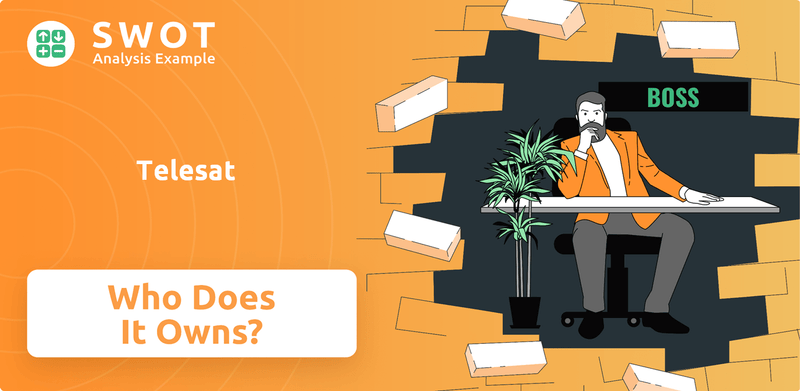
This deep dive into Telesat's ownership will explore the key players, including major investors and Telesat shareholders, who have shaped the company's trajectory. We'll examine Telesat's history, from its founding to its evolution as a global satellite communications leader, shedding light on the company's ownership structure and its impact on its operations. Discover who is the current CEO of Telesat and how to invest in Telesat.
Who Founded Telesat?
The story of Telesat begins in 1969, when it was established as Telesat Canada. This marked the start of a major player in the satellite communications field. The company was created by an Act of Parliament, setting the stage for its unique ownership structure.
Initially, Telesat was a Crown corporation. This meant it was jointly owned by the Canadian federal government and the Stentor Canadian Network Management, a consortium of Canadian telecommunications companies. This setup reflected the Canadian government's strategic interest in developing satellite communications infrastructure across the country.
While the exact details of the founders and their initial stakes aren't available in public records, the government's involvement highlighted the national importance of the project. The goal was to provide essential telecommunications services, especially in remote areas. This early structure laid the groundwork for Telesat's future as a key provider of satellite services.
Telesat Canada was founded in 1969 as a Crown corporation. The ownership was shared between the Canadian government and Stentor Canadian Network Management.
In 1972, Telesat launched Anik A1. This was a significant milestone as the world's first domestic communications satellite in geostationary orbit operated by a commercial company.
Telesat held a legal monopoly on Earth stations in Canada until February 1979. This meant that any entity needing to send or receive satellite signals had to lease from Telesat.
The founding vision, shaped by government ownership, was to provide essential telecommunications services across Canada. This was especially important for remote areas.
The government's involvement reflected a national strategic interest in developing Canada's satellite communications infrastructure.
The early operational and financial landscape of the company was significantly shaped by its legal monopoly.
Understanding the history of Telesat's target market is important. The company's initial structure, with government and consortium ownership, set the stage for its role in the satellite industry. The launch of Anik A1 and the early monopoly shaped its development. This early phase was critical in establishing Telesat as a major player, with its ownership reflecting a commitment to providing essential services across Canada. The company's early focus was on serving the entire country, particularly remote areas, which influenced its business strategy and operational decisions.
Telesat SWOT Analysis
- Complete SWOT Breakdown
- Fully Customizable
- Editable in Excel & Word
- Professional Formatting
- Investor-Ready Format
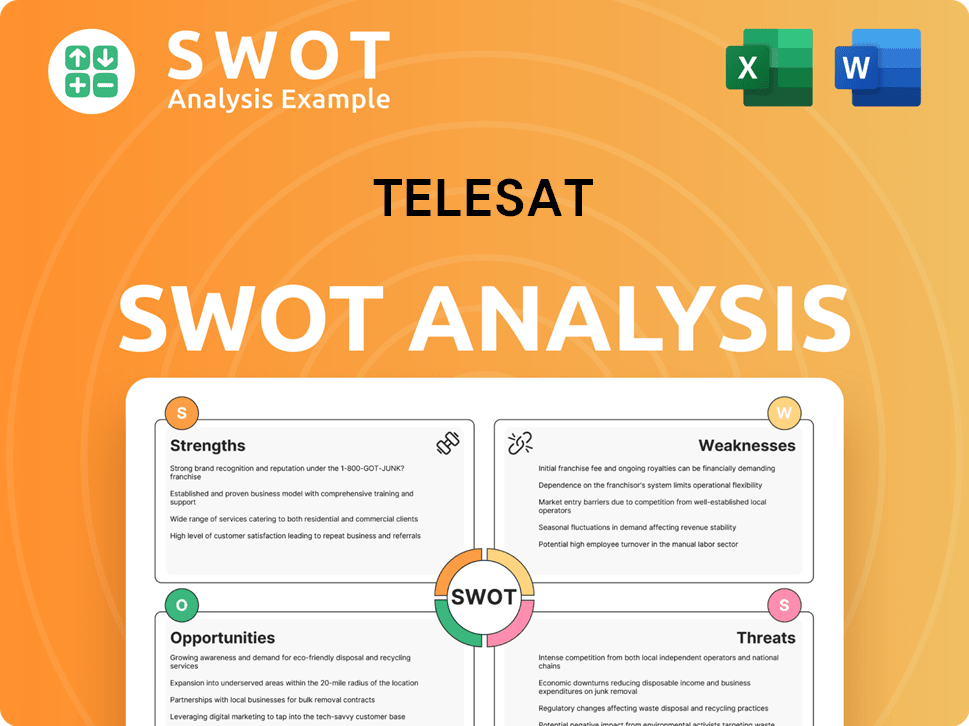
How Has Telesat’s Ownership Changed Over Time?
The evolution of Telesat ownership reflects significant shifts since its inception. Initially, the Canadian federal government held a stake, which was divested in 1992. Subsequently, Bell Canada Enterprises (BCE) took full control in 1998. This set the stage for a major transition in 2007 when Loral Space & Communications, in partnership with the Public Sector Pension Investment Board (PSP Investments), acquired the company.
A pivotal moment occurred in November 2021 when Telesat became a public company, listed on Nasdaq and the TSX under the ticker 'TSAT'. This involved the merger of Loral Space & Communications and Telesat Canada into a new Canadian-controlled public holding company. This transition marked a new chapter in Telesat's ownership structure, opening it up to public and institutional investors while maintaining a significant Canadian presence.
| Year | Ownership Change | Details |
|---|---|---|
| 1992 | Government Divestiture | Federal government sold its stake to Alouette Telecommunications, Ltd. |
| 1998 | BCE Acquisition | Bell Canada Enterprises (BCE) acquired 100% ownership. |
| 2007 | Loral and PSP Investments Acquisition | Loral Space & Communications, with PSP Investments, acquired Telesat from BCE for approximately USD 2.8 billion (CAD 3.25 billion). |
| 2021 | Public Listing | Telesat became a public company, listed on Nasdaq and TSX under 'TSAT'. |
As of March 31, 2025, the institutional investors collectively own 137.21% of Telesat. Insiders hold 3.85%. The Public Sector Pension Investment Board remains the largest institutional shareholder, controlling 126.06% of TSAT shares (18.21 million shares). MHR Fund Management LLC holds 125.41% (18.04 million shares), and Gamco Investors, Inc. et al holds 13.37% (1.93 million shares). These figures highlight the substantial influence of institutional investors, particularly PSP Investments, in shaping Telesat's strategic direction. For more insights into their mission, check out the Growth Strategy of Telesat.
Telesat's ownership has evolved significantly, from government control to private ownership and finally, public listing. The current ownership structure is dominated by institutional investors, with PSP Investments holding a significant stake.
- Telesat is now a publicly traded company, listed on Nasdaq and the TSX.
- Institutional investors hold a significant majority of Telesat's shares.
- The Public Sector Pension Investment Board (PSP Investments) is the largest shareholder.
Telesat PESTLE Analysis
- Covers All 6 PESTLE Categories
- No Research Needed – Save Hours of Work
- Built by Experts, Trusted by Consultants
- Instant Download, Ready to Use
- 100% Editable, Fully Customizable
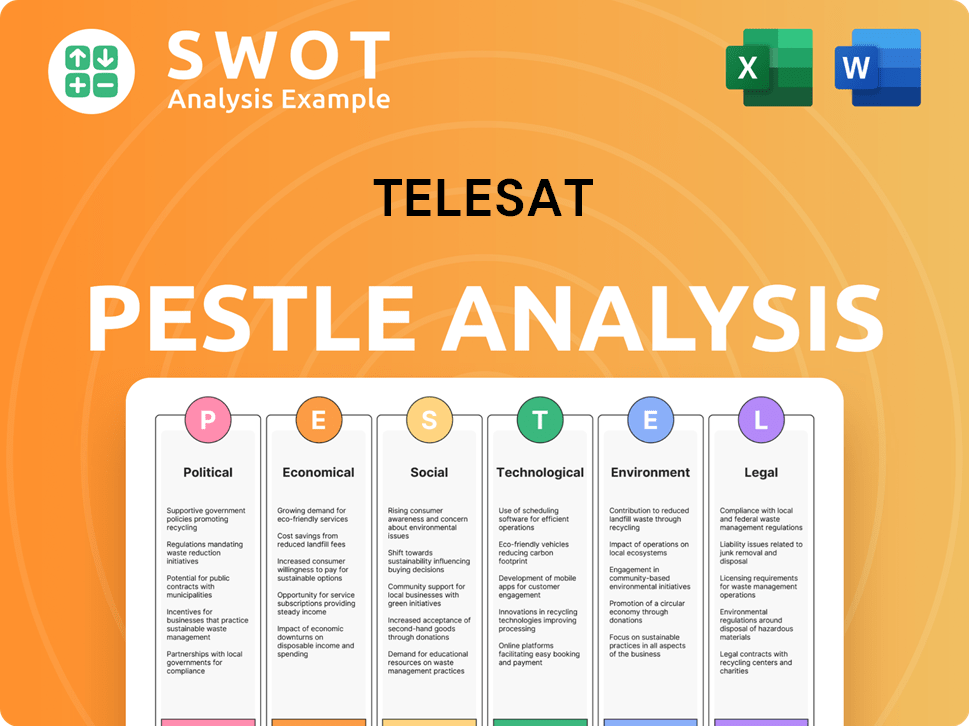
Who Sits on Telesat’s Board?
The current board of directors of the Telesat company oversees the strategic direction and governance of the organization. While specific details of the board's composition, including affiliations of individual members, are best found in the company's SEC filings and annual reports, it is known that the board includes representatives from major shareholders and independent members. The President and Chief Executive Officer, Daniel S. Goldberg, is a key figure in the company's leadership.
The board's structure reflects the company's commitment to maintaining Canadian control, a provision established during its transition to a public company in 2021. Major shareholders, such as the Public Sector Pension Investment Board and MHR Fund Management LLC, have significant influence on the company's strategic decisions and governance due to their substantial holdings. This influence is typically exercised through representation on the board and through their voting power.
| Board Member | Title | Affiliation |
|---|---|---|
| Daniel S. Goldberg | President and Chief Executive Officer | Telesat |
| (Information available in SEC filings) | (Information available in SEC filings) | (Information available in SEC filings) |
| (Information available in SEC filings) | (Information available in SEC filings) | (Information available in SEC filings) |
The Telesat ownership structure and its commitment to Canadian control are important aspects of its governance. The company's history includes a transition to a public company, which was structured to ensure that Canadian interests are maintained. For more information, explore the Competitors Landscape of Telesat.
The Telesat company is structured to maintain Canadian control, with major shareholders influencing strategic decisions. The board of directors includes representatives from major shareholders and independent members.
- Daniel S. Goldberg is the President and CEO.
- Public Sector Pension Investment Board and MHR Fund Management LLC are major shareholders.
- The company transitioned to a public structure in 2021.
- SEC filings and annual reports provide detailed information on the board and ownership.
Telesat Business Model Canvas
- Complete 9-Block Business Model Canvas
- Effortlessly Communicate Your Business Strategy
- Investor-Ready BMC Format
- 100% Editable and Customizable
- Clear and Structured Layout
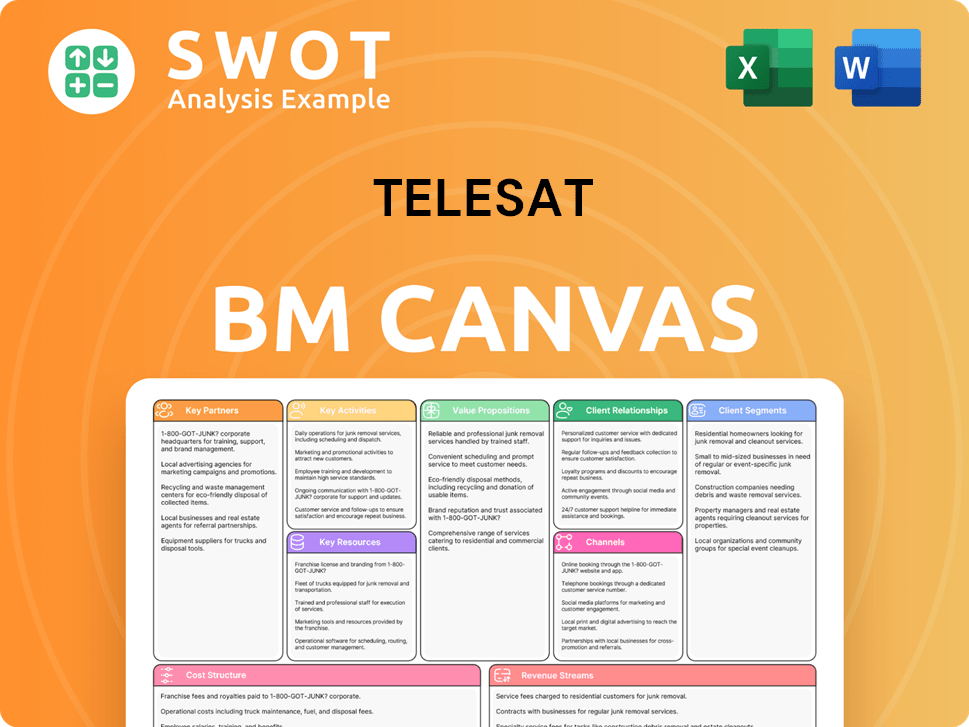
What Recent Changes Have Shaped Telesat’s Ownership Landscape?
Over the past few years, the ownership landscape of the Telesat company has seen notable shifts. A significant development was the securing of $2.54 billion in loan financing from the Canadian and Quebec governments for the Telesat Lightspeed project, announced in September 2024, with the first funds received in January 2025. This government support highlights a degree of public sector influence on the company's strategic direction, particularly regarding its Low Earth Orbit (LEO) constellation. This financial backing reinforces the company's initiatives.
In January 2025, Telesat announced key executive changes. Michel Forest took over as Chief Technology Officer, and Asit Tandon became Chief Network and Information Officer. Andrew Browne, the Chief Financial Officer, announced his retirement plans for later in 2025. These leadership changes, while not direct ownership alterations, can still influence strategic decisions and investor confidence. Furthermore, the company has been repurchasing debt, reducing its overall debt burden and potentially enhancing shareholder value. For example, in 2024, Telesat repurchased $262 million of debt for $190 million.
| Metric | Value | Year |
|---|---|---|
| Debt Repurchased | $262 million | 2024 |
| Debt Repurchase Cost | $190 million | 2024 |
| 1-Year Share Buyback Ratio | -5.20% | March 2025 |
| 3-Year Share Buyback Ratio | -5.70% | March 2025 |
The satellite communications industry is experiencing trends such as increasing institutional ownership of companies like Telesat. The rise of LEO constellations, like Telesat Lightspeed, is reshaping the industry. This competitive environment necessitates innovation and strategic partnerships. For instance, Telesat has agreements with Space Norway, Orange, and ADN Telecom for Lightspeed services. The financial outlook for 2025 anticipates challenges, with projected revenue declines to $405-$425 million and Adjusted EBITDA expected to drop to $170-$190 million. For more details, consider the Growth Strategy of Telesat.
Telesat's ownership structure has evolved, with government financing and institutional investors playing key roles. The company's debt repurchase strategy aims to improve shareholder value, while leadership changes influence strategic direction.
The company faces challenges with projected revenue declines to $405-$425 million and Adjusted EBITDA expected to drop to $170-$190 million in 2025. These figures reflect ongoing investments in LEO infrastructure.
The satellite industry is undergoing significant changes, including the growth of LEO constellations and increased competition. Telesat is responding with strategic partnerships and technological advancements.
Telesat's future hinges on its LEO network and its ability to navigate a dynamic market. The company's strategic initiatives are crucial for long-term success.
Telesat Porter's Five Forces Analysis
- Covers All 5 Competitive Forces in Detail
- Structured for Consultants, Students, and Founders
- 100% Editable in Microsoft Word & Excel
- Instant Digital Download – Use Immediately
- Compatible with Mac & PC – Fully Unlocked
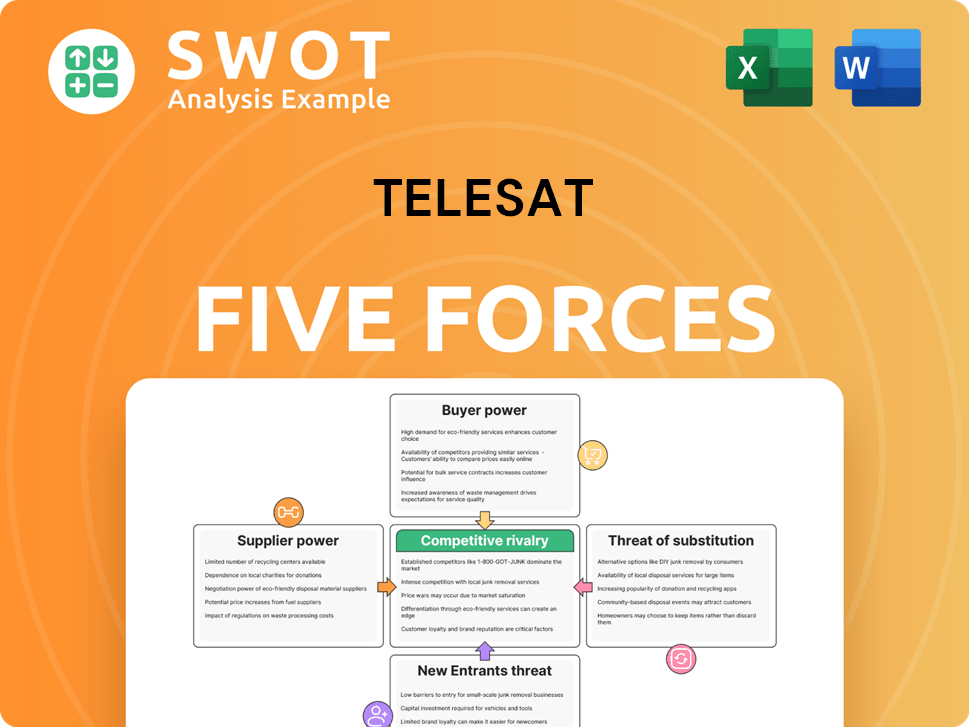
Related Blogs
- What are Mission Vision & Core Values of Telesat Company?
- What is Competitive Landscape of Telesat Company?
- What is Growth Strategy and Future Prospects of Telesat Company?
- How Does Telesat Company Work?
- What is Sales and Marketing Strategy of Telesat Company?
- What is Brief History of Telesat Company?
- What is Customer Demographics and Target Market of Telesat Company?
Disclaimer
All information, articles, and product details provided on this website are for general informational and educational purposes only. We do not claim any ownership over, nor do we intend to infringe upon, any trademarks, copyrights, logos, brand names, or other intellectual property mentioned or depicted on this site. Such intellectual property remains the property of its respective owners, and any references here are made solely for identification or informational purposes, without implying any affiliation, endorsement, or partnership.
We make no representations or warranties, express or implied, regarding the accuracy, completeness, or suitability of any content or products presented. Nothing on this website should be construed as legal, tax, investment, financial, medical, or other professional advice. In addition, no part of this site—including articles or product references—constitutes a solicitation, recommendation, endorsement, advertisement, or offer to buy or sell any securities, franchises, or other financial instruments, particularly in jurisdictions where such activity would be unlawful.
All content is of a general nature and may not address the specific circumstances of any individual or entity. It is not a substitute for professional advice or services. Any actions you take based on the information provided here are strictly at your own risk. You accept full responsibility for any decisions or outcomes arising from your use of this website and agree to release us from any liability in connection with your use of, or reliance upon, the content or products found herein.